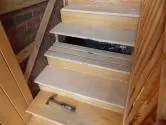A Man and His Machines

It was a short journey down the twelve steps from my second floor office to my garage workshop this weekend, where I was refinishing five oak stairs treads I had just pried loose from our split-level landing, but it took me halfway across the country back to Iowa City and the House of Wood.
The year was 1979 and it marked two important occasions in my life: a change in careers and my introduction to the Arts and Crafts movement. And both happened at House of Wood, a woodworking and antique refinishing shop where I got a part time job as an apprentice working under Jim Bohenkamp, a professional woodworker from Colorado.
Jim knew wood and he knew machinery, but it soon became apparent that I had learned more from my grandmother about antiques and refinishing than Jim had along the way.
And it taught me something I have never forgotten: you will learn more about woodworking from antiques than you can about antiques from woodworking. Once you have disassembled, repaired, restored, and reassembled a fine antique, you know more about joinery and design than you can learn in any textbook.
While there was no fine joinery in my oak stair treads, there was excessive wear from thousands of trips up and down the stairs, including more than a few by our two dogs. Not only was the polyurethane worn off in some places, but the wood had turned nearly black from standing water tracked in on our boots. And it was there in my workshop, looking first at the five battered stair treads and then at my Dewalt planer, that I thought about Jim and the walnut table.
One day, not long after I had gone to work at House of Wood, a sophisticated antiques collector brought in a mid-19th century walnut dropleaf table with two badly warped drop-leaves. He wanted it restored and the leaves flattened. Now I had read George Grotz’s books on refinishing and knew the proper, but slow way to flatten these leaves would be to apply moisture to one side and gradual pressure to the other. As I explain to Jim how it would work, I could see his eyes glass over.

“I’ve got a better idea,” he said, taking the first of the cupped drop leaves over to his gigantic planer. “We’ll just skim a tiny fraction off the top until its perfectly flat.”
Well, the first pass left a streak of fresh, exposed walnut at the far right and the far left sides, as they were the cupped portions of the leaf. The second pass widened the streaks of exposed, skimmed walnut, narrowing the darker, untouched valley between them. Jim continued cranking the blades lower and running the two leaves through, watching as each leaf grew flatter as the blades kept skimming raised wood off the outer edges.
“Just one more pass,” he declared as we stood by nervously.
One more pass did it, but it also exposed nine screw holes left by the three screws in each of the three hinges on the underside of the leaf. The leaf was certainly flat, but the outer edges were each now just a half-inch thick — with no way to hold the screws needed to reattach it.
Obviously, the table was ruined. Jim basically threw it at me and while I made a gallant effort to plug the holes and recreate the lost patina, I will never forgot the look of disgust, disappointment, and loss on the owner’s face.
And so today my joiner remained silent, as I took the slow, but safe approach and sanded down each of my five oak stair treads, keeping enough of the wear to still make them match the rest of the woodwork.

Until next Monday,
Thanks for stopping by!
Bruce
Top: Stairwell as I was removing treads and installing temporary replacements.
Middle: The refinished stair treads drying in my workshop.
